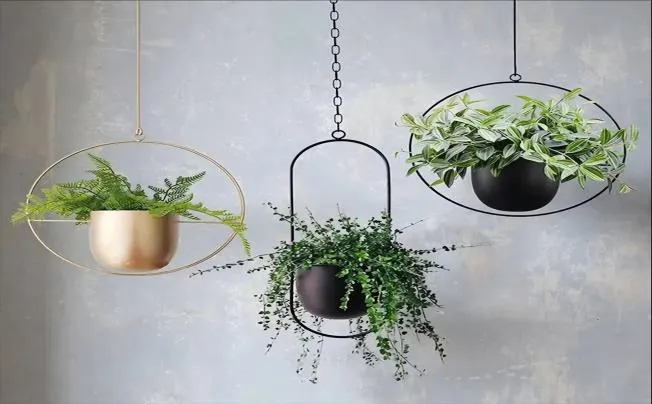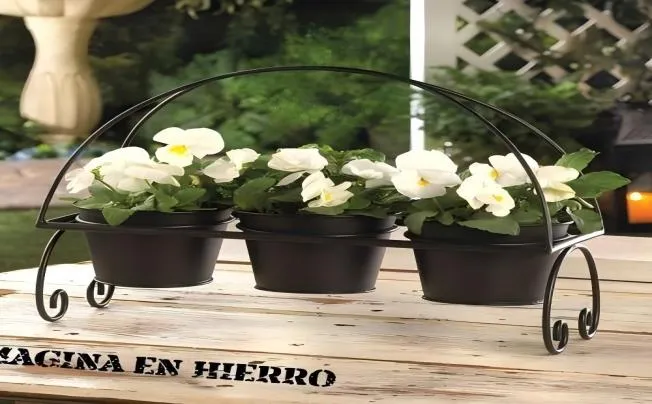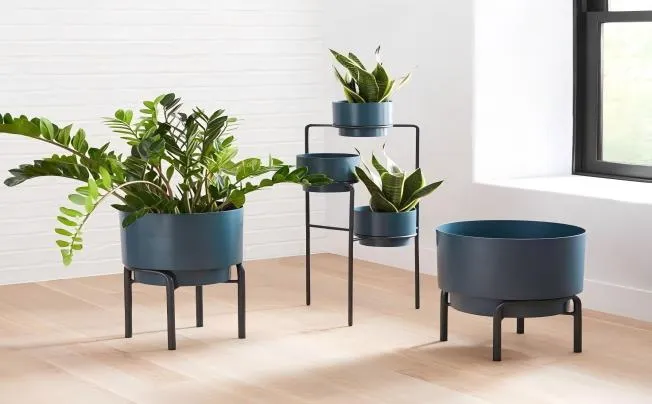How To Waterproof A Metal Planter?
In gardening decoration, metal flower pots have become the favorite of many flower lovers due to their unique texture and modern style.
Preparation before waterproofing
Selecting an appropriate metal flower container
First, it is impossible to overlook the material's thickness. Stronger structural support from thicker metal materials, such stainless steel flower pots, can increase the flower pots' durability and reduce their propensity to distort from water erosion or outside influences. At the same time, look for any coating on the flower pot when examining the material. Certain metal flower pots can withstand water erosion to a certain degree and postpone corrosion if they have superior anti-rust coatings.
Another crucial factor to take into account when choosing is the pot body's structure. Examine the flower container for any holes, cracks, or weak spots in the welding. Water can seep through even the smallest cracks. Water collection can be successfully prevented by selecting a flower pot with a drainage hole at the bottom. However, to improve water management throughout the waterproofing process, care should be taken when closing the drainage hole.
Prepare the materials required for waterproofing
1. First, prepare the materials needed for waterproofing. Waterproof coating is the main component of waterproofing. While there are many other kinds of waterproof coatings available, the most popular ones are polyurethane and acrylic. Acrylic waterproof coatings are easy to use, dry quickly, and are resistant to chemicals and weather. The majority of metal flower pots can be waterproofed with it. Make sure it is appropriate for metal surfaces and has high waterproof performance and durability by carefully reading the product instructions before making your selection.
2. Another essential item is waterproof tape. To improve the waterproof effect, it can be used to seal the flower pot's edges, gaps, and other areas. watertight tape can swiftly build a watertight barrier in a variety of difficult situations and has exceptional flexibility, excellent weather resistance, and resistance to chemical damage.
3. To improve the waterproof sealing even more, sealant can be used to patch minor cracks and holes in flower pots. Sealant has a certain amount of adhesion, is difficult to flow, and can distort depending on the shape of the sealing surface. It is frequently used to seal parts in electronic products, civil engineering, and other domains. Polyurethane and silicone sealants are examples of common sealants. Polyurethane sealants have a high bonding strength and flexibility, whilst silicone sealants are waterproof and weather resistant.
4. In terms of building supplies, you must get a brush ready for applying waterproof paint so that the metal flower pot's surface is evenly coated. A smoother brushing effect can be achieved by selecting a high-quality brush with soft bristles. Metal flower pots can have their surfaces polished with sandpaper, which also makes the surface rougher and enhances paint adherence. To prevent scratching the flower pot's surface, use uniform force when polishing.
5. To guarantee health and safety throughout the procedure, you can also prepare some protective gear, such as masks and gloves.

Detailed explanation of waterproofing steps
Clean the surface of the flower pot
First, gently clean the flower pot's exterior and interior surfaces with water and a moderate detergent. You may gently wipe out tough stains like rust and oil stains with a soft cloth or sponge. Sandpaper can be used to polish rust spots that are hard to get rid of, but use moderate power to prevent over polishing and damaging the flower pot's surface. Make sure there is no detergent residue on the flower pot's surface by rinsing it with clean water after cleaning. To prepare for later waterproofing, make sure the flower pot is totally dry before placing it in a well-ventilated area to dry.
Filling in gaps and holes in flower pots
The weak points of waterproofing are the gaps and holes in the flower pot, so they need to be handled carefully. For smaller gaps, you can use sealant; clean the area around the gap to make sure there is no dust or impurities, then squeeze the sealant into the gap evenly, compact it with a tool, and smooth it so that it is flush with the flower pot's surface. For larger holes, you can cover them with waterproof tape first, then apply sealant on the tape to further improve the waterproof effect.
Put on a waterproof layer
Selecting the appropriate waterproof coating, such as the previously mentioned polyurethane or acrylic waterproof coating, is crucial. Make sure the coating is equal and sediment-free by giving it a good swirl before applying. Apply the waterproof coating evenly from the bottom of the flower container upwards using a brush or roller, following the directions. Be cautious to prevent issues like bubbles and missing brushes throughout the application process. If bubbles are generated, they should be punctured and smoothed with a brush in time. Generally, 2-3 layers are required, and sufficient drying time should be allowed between each layer. The specific time can be referred to the coating product manual. When applying the last layer of paint, ensure that the surface is flat and smooth to form a complete and effective waterproof barrier.

Maintenance after waterproofing
Daily use precautions
First, keep your hands away from sharp items that could scratch the flower pot's surface and lose the waterproof effect; second, move the flower pot carefully to prevent collisions with other hard objects.
At the same time, keep the flower pot out of the sun for as long as possible. Long-term sun exposure can age and degrade the waterproof coating, reducing its waterproof effectiveness even though it has some weather resistance. If the flower container is outside, pick a spot that receives some shade, or cover it when the summer sun is really strong.
When watering, adhere to sensible watering guidelines. Water sparingly to prevent water buildup, taking into account the needs of the plants and seasonal variations. Soaking the flower pot's bottom with accumulated water for an extended period of time may affect the waterproof effect. To further prevent the effect of the water flow from harming the flower pot's waterproof covering, try to avoid putting water directly on it when watering.
Frequent upkeep and inspection
Every now and then, carefully inspect the flower pot to see whether the coating is ageing or if the surface is damaged. The flower pot's borders, cracks, drainage holes, and other trouble spots are the main focus of the examination.
It can be fixed quickly if a small patch of the waterproof coating peels off or is discovered to be somewhat worn. Apply the waterproof coating locally to the peeled or worn areas using the same method as before. Make sure the coverage is moderately thick and distributed evenly. The waterproof performance can be partially recovered after drying.
To guarantee that the flower pot may remain well waterproof, it is advised to re-waterproof it when it is discovered that the coating is badly deteriorated, huge sections are broken, or the waterproof effect is greatly diminished. To guarantee that the metal flower pot's waterproof function is constantly in good condition and that plants are growing in a stable and dependable environment, clean the flower pot's surface first, then reapply the waterproof coating in accordance with the earlier waterproofing processes.

Selected Blogs
-
What customization services are available for metalworking customization?
2024-12-12
-
What Is The Difference Between A Plant Container And A Raised Bed?
2024-04-23
-
Garden Screening & Fence Panels
2024-04-23
-
Gardening pot selection tips
2024-04-17
-
The function and collocation of horticultural fire pot
2024-04-17


